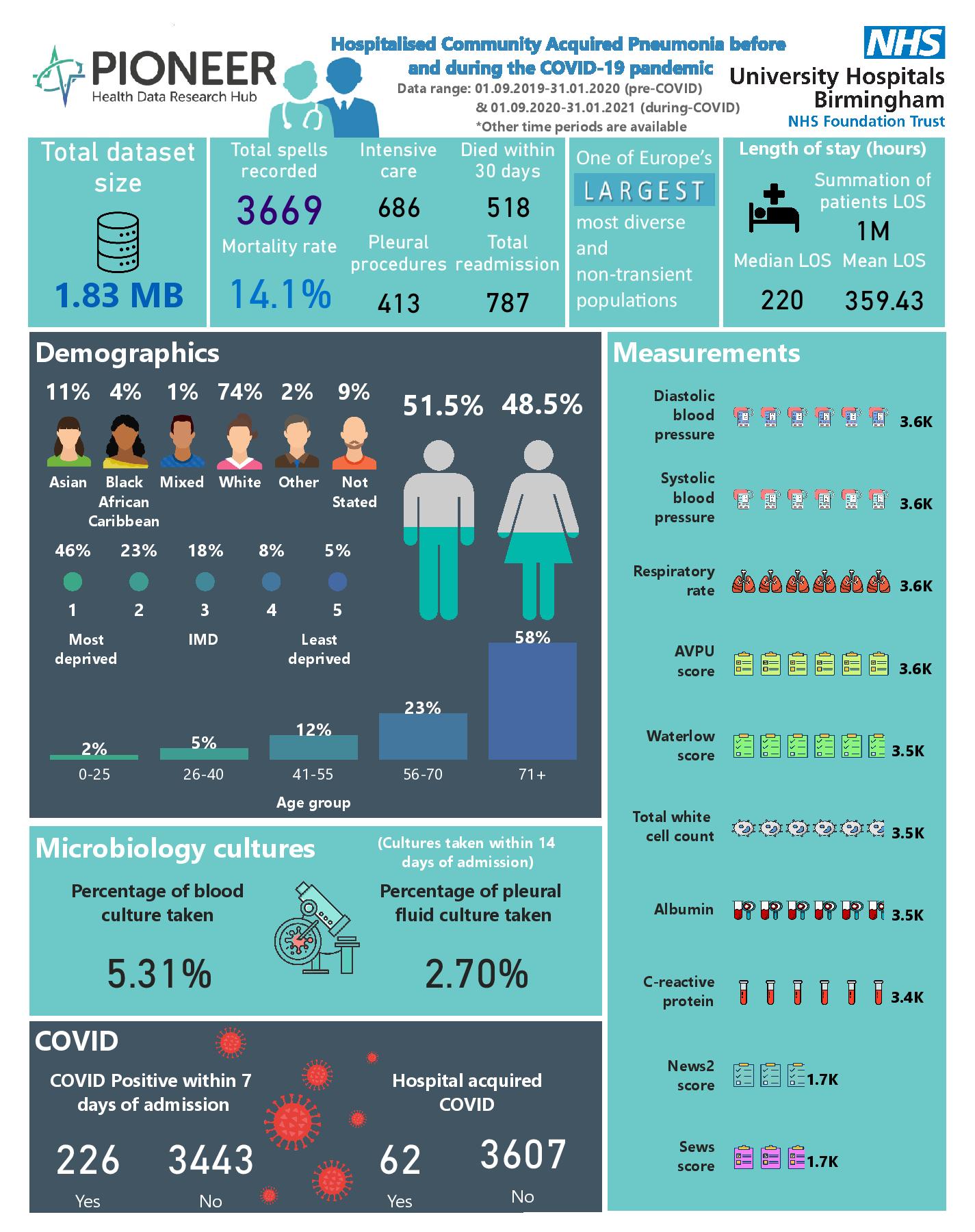Version: 1.0.0 | Published: 8 Oct 2024 | Updated: 425 days ago
Hospitalised Community Acquired Pneumonia before & during the COVID-19 pandemic
Dataset

Documentation
Associated Media:
Description:
Community acquired pneumonia (CAP) is a leading cause of hospital admission, and in older adults has high rates of mortality and complications. CAP is associated with increased long-term mortality and loss of independence for older adults. CAP typically affects older adults with co-morbidities- a group who have largely shielded throughout the winter period. This seems to have reduced rates of transmissible disease in vulnerable people. Complications such as sepsis, and empyema (infected fluid around the lung) prolong hospital admission, result in additional interventions in hospital and have higher mortality than CAP alone. The causative agents for CAP are often poorly identified in real world clinical practice.
These data allow the investigation of the different ways in which COVID-19 has impacted on existing health conditions, how often causative agents were identified in real-world practice and the sensitivities of the bacteria, which antibiotics were used and patient outcomes.
PIONEER geography
The West Midlands (WM) has a population of 5.9 million & includes a diverse ethnic & socio-economic mix (42% non-white within Birmingham).
EHR. UHB is one of the largest NHS Trusts in England, providing direct acute services & specialist care across four hospital sites, with 2.2 million patient episodes per year, 2750 beds & an expanded 250 ITU bed capacity during COVID. UHB runs a fully electronic healthcare record (EHR) (PICS; Birmingham Systems), a shared primary & secondary care record (Your Care Connected) & a patient portal “My Health”.
Scope: All hospitalised patients admitted to UHB before and during the COVID-19 pandemic, curated to focus on Community Acquired Pneumonia. Longitudinal & individually linked, so that the preceding & subsequent health journey can be mapped & healthcare utilisation prior to & after admission understood. The dataset includes highly granular patient demographics & co-morbidities taken from ICD-10 & SNOMED-CT codes. Serial, structured data pertaining to process of care (timings, admissions, readmissions and discharge outcomes, physiology readings (heart rate, blood pressure, NEWS2 score, SEWS score, AVPU score), blood results and flags for microbiology and surgical data. Comparing the burden of hospitalised community acquired pneumonia (CAP) before and during COVID-19 pandemic.
Available supplementary data: Matched controls; ambulance, synthetic data.
Available supplementary support: Analytics, Model build, validation & refinement; A.I.; Data partner support for ETL (extract, transform & load) process, Clinical expertise, Patient & end-user access, Purchaser access, Regulatory requirements, Data-driven trials, “fast screen” services.
Coverage
Spatial:
United Kingdom,England,West Midlands
Typical Age Range:
18-110
Follow Up:
1 - 10 Years
Pathway:
Data is representative of the multi-ethnicity population within the West
Midlands (42% non white). Data includes all patients admitted during this
timeframe, with National data Opt Outs applied, and therefore is representative
of admissions to secondary care. Data focuses on in-patient stay in hospital
during the acute episode but can be supplemented on request to include previous
and subsequent hospital contacts (including outpatient appointments) and
ambulance, 111, 999 data.
Provenance
Origin
Purposes:
Care
Sources:
EPR
Collection Situations:
- Secondary care - Accident and Emergency
- Secondary care - Outpatients
- Secondary care - In-patients
Temporal
Accrual Periodicity:
Quarterly
Distribution Release Date:
13 May 2021
Start Date:
31 August 2019
End Date:
31 January 2021
Time Lag:
Other
Accessibility
Access
Access Service:
Trusted Research Environments (TRE) are built using Microsoft Azure services and
hosted in the UK to provide research teams a safe, secure and agile environment
which allows users to quickly analyse, interpret and form an enriched view of
primary care information through a range of integrated datasets. Health data
collated from multiple sources is ingested into a secure data lake which will
then allow subsets of data to be made available to research teams on approval of
a data request. Once approved a customer specific TRE is made available with a
standard set of leading analytical tools from Microsoft including Azure
Databricks, Azure Machine Learning, Azure SQL and Azure Synapse (for large-scale
data warehouses). Specific tools can be provided at an additional cost over the
standard platform data access charge and the PIONEER team will work with you to
determine your exact needs. Access to the TRE is managed using the latest
virtual desktop technology to provide a safe and secure end-user experience. By
utilising leading edge design PIONEER are able to create TREs rapidly to enable
us to service any customer requirement.
Access Request Cost:
www.pioneerdatahub.co.uk/data/data-services-costs/
Delivery Lead Time:
1-2 months
Jurisdictions:
GB-ENG
Data Controller:
University Hospitals Birmingham NHS Foundation Trust
Usage
Data Use Limitations:
General research use
Data Use Requirements:
Project-specific restrictions
Resource Creators:
This publication uses data from PIONEER, an ethically approved database and analytical environment (East Midlands Derby Research Ethics 20/EM/0158)
Format and Standards
Vocabulary Encoding Schemes:
- SNOMED CT
- ICD10
Conforms To:
LOCAL
Languages:
en
Formats:
SQL
Observations
Statistical Population
Population Description
Population Size
Measured Property
Observation Date
Persons
3,669 CAP spells in this dataset from 2019-09-01 to 2020-01-31 and 2020-09-01 to 2021-01-31
3669
Count
13 May 2021
